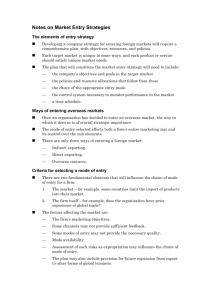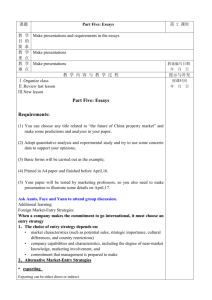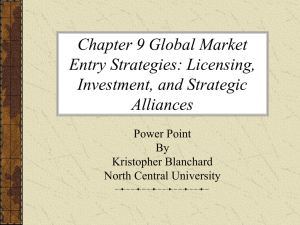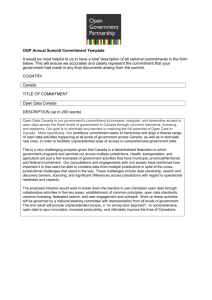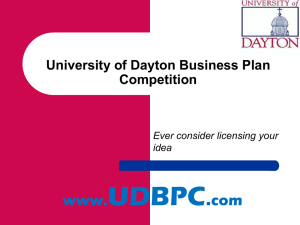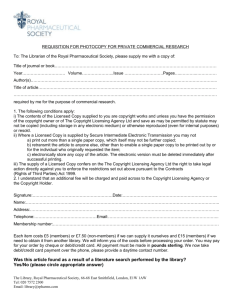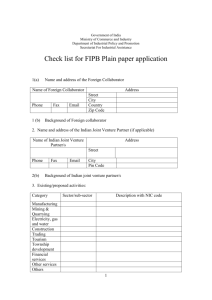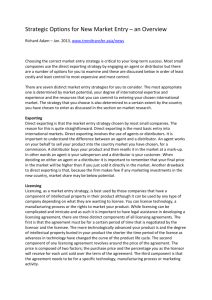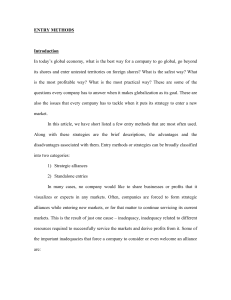Global Market Entry Strategies: Licensing, Exporting & More
advertisement
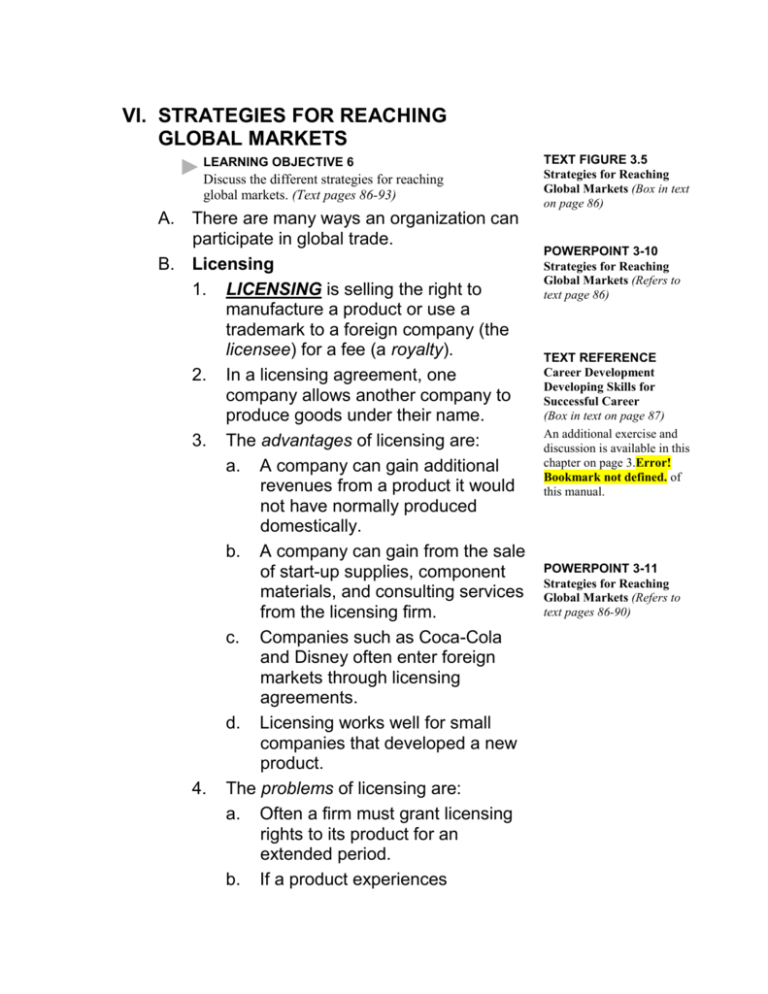
VI. STRATEGIES FOR REACHING GLOBAL MARKETS OBJECTIVE 6 ► LEARNING Discuss the different strategies for reaching global markets. (Text pages 86-93) A. There are many ways an organization can participate in global trade. B. Licensing 1. LICENSING is selling the right to manufacture a product or use a trademark to a foreign company (the licensee) for a fee (a royalty). 2. In a licensing agreement, one company allows another company to produce goods under their name. 3. The advantages of licensing are: a. A company can gain additional revenues from a product it would not have normally produced domestically. b. A company can gain from the sale of start-up supplies, component materials, and consulting services from the licensing firm. c. Companies such as Coca-Cola and Disney often enter foreign markets through licensing agreements. d. Licensing works well for small companies that developed a new product. 4. The problems of licensing are: a. Often a firm must grant licensing rights to its product for an extended period. b. If a product experiences TEXT FIGURE 3.5 Strategies for Reaching Global Markets (Box in text on page 86) POWERPOINT 3-10 Strategies for Reaching Global Markets (Refers to text page 86) TEXT REFERENCE Career Development Developing Skills for Successful Career (Box in text on page 87) An additional exercise and discussion is available in this chapter on page 3.Error! Bookmark not defined. of this manual. POWERPOINT 3-11 Strategies for Reaching Global Markets (Refers to text pages 86-90) remarkable growth in the foreign market, the bulk of the revenues go to the licensee. c. If the foreign licensor learns the technology, it may break the agreement and begin to produce a similar product on its own. C. Exporting 1. Export assistance centers (EACs) were created by the U.S. government to provide hands-on exporting assistance and trade-finance support for small and medium-sized businesses. 2. Small and medium-sized firms represent 95% of exporters. 3. To overcome small firms’ reluctance, export-trading companies can match buyers and sellers from different countries. 4. Export trading companies also help exporters reduce a key risk—getting paid. D. Franchising 1. A FRANCHISING AGREEMENT is an arrangement whereby someone with a good idea for a business sells the rights to use the business name and sell a product or a service to others in a given territory. a. The FRANCHISOR is a company that develops a product concept and sells others the rights to make and sell the product. b. The FRANCHISEE is the person who buys a franchise. 2. Franchising is popular both domestically and in global markets. 3. Franchising allows the use of an entire concept, not just the product. 4. Franchisers must adapt in the countries they serve. a. KFC failed in Hong Kong because consumers considered it too greasy. b. Pizza Hut found that Germans like small, individual pizzas. c. Domino’s Pizza found that Japanese enjoyed squid and sweet mayonnaise pizza. E. Contract Manufacturing 1. CONTRACT MANUFACTURING is when one country produces goods with another country’s company label on it; this is also called outsourcing. 2. Example, Dell Computer using Quanta Computers 3. Using contract manufacturing a company can often experiment in a new market without heavy start-up costs. 4. A firm can also use contract manufacturing temporarily to meet an unexpected increase in orders. 5. A major disadvantage is that intellectual property and copyright laws differ from country to country (example: China). F. International Joint Ventures and Strategic Alliances 1. A JOINT VENTURE is a partnership in TEXT REFERENCE Thinking Critically: McDonalizing the World (Box in text on page 89) In all markets in which McDonald’s operates, the company continuously listens to customers and adapts to their culture and preferences. POWERPOINT 3-12 Strategies for Reaching Global Markets (Refers to text pages 90-92) 2. 3. 4. 5. 6. 7. which two or more companies (often from different countries) join to undertake a major project for a specific time period. The text offers the example of the joint venture among Volkswagen, General Motors, and China’s Shanghai Automotive Industrial Corporation. A unique joint venture is that between University of Pittsburg and the government of Italy to build a medical transplant center in Italy. The benefits of joint venture include: a. Shared technology. b. Shared marketing and management expertise. c. Entry into markets where foreign companies are not allowed unless their goods are produced locally. d. Shared risk. The drawbacks are: a. One partner can learn the technology and practices of the other and leave to become a competitor. b. The technology may become obsolete. c. The partnership may be too large to be as flexible as needed. In a GREENFIELD INVESTMENT, a company decides to enter a country and build offices and production facilities. A STRATEGIC ALLIANCE is an agreement between two or more companies to work together to achieve TEXT REFERENCE Ethical Challenge: Doing Bad by Trying to Do Good (Box in text on page 92) The CEO of a major pharmaceutical manufacturer has announced plans to donate its AIDS drugs to government clinics in several competitive market advantages. a. Alliances can provide access to markets, capital, and technical expertise. b. They usually do not involve sharing costs, risks, management, or profits. c. Strategic alliances can be flexible and can be effective between firms of different sizes. d. The text uses several examples, such as Motorola and Oracle Corporation. G. FOREIGN DIRECT INVESTMENT is buying permanent property and business in foreign nations. 1. A FOREIGN SUBSIDIARY is a company owned in a foreign country by another company (parent company). a. The legal requirements of both the parent (home) and the foreign (host) countries must be observed. b. The advantage of foreign subsidiaries is that the company maintains complete control over any technology or expertise it may possess. c. The major disadvantage is EXPROPRIATION, when a host government takes over a foreign subsidiary in a country. d. The text uses the example of consumer giant Nestlé as a company with many foreign subsidiaries. developing countries. She is surprised by the criticism of her actions by many humanitarian groups, who prefer that the drug price be lowered for everyone, not just selected patients. POWERPOINT 3-13 Strategies for Reaching Global Markets (Refers to text pages 92-93) CRITICAL THINKING EXERCISE 3-2 Evaluating Global Expansion One company is faced with the decision of whether or not to enter a joint venture with a Latin American country. (See complete exercise on page 3.Error! Bookmark not defined. of this manual.) LECTURE LINK 3-3 2. 3. Multinational corporations a. A MULTINATIONAL CORPORATION is an organization that manufactures and markets products in many different countries; it has multinational stock ownership and multinational management. b. Only firms that have manufacturing capacity or other physical presence in different nations can truly be called multinational. Different strategies reflect different levels of ownership, financial commitment, and risk. SELF CHECK QUESTIONS (Text page 93) 1. 2. 3. Why would a firm choose to export rather than become involved in a joint venture? What do you think would be the best way to get involved in global business as a small soap manufacturer? What are the advantages and disadvantages of creating a subsidiary? Why There Are No Indian Wal-Marts There are millions of small shop owners in India that are fighting to keep the big retail chains out of the country. (See complete lecture link on page 3.Error! Bookmark not defined. of this manual.)
